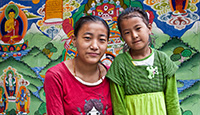[Under the heading "Add-Ons" you will find personal contributions to the site of Stichting Milijuli.
The sub-headings "Tours/Treks" and "Pictures" are contributions of Ton van der Kop].
My visits to Nepal
Index:
IntroductionRecommendations
1997: Everest trek, starting from Lukla
1998: Kanchenjunga
2000: Everest trek, starting from Jiri
2001: Duble + Annapurna, the hard way
2002: Tibet + Chitwan
2003: - Spring - Okhaldhunga (Duble) + Chitwan
2003: - Autumn - Everest Base Camp in Nepal + Annapurna Base Camp
2004: Langtang + Tibet + Chitwan. (still to write)
2005: Annapurna (round Annapurna + Manaslu) + Okhaldunga. (still to write)
2006: Langtang + Helambu + Chitwan. (still to write)
2007: Chitwan + Lumbini. (to write)
2008: - Spring - Okhaldhunga (Duble) + Chitwan. (still to write)
2008: - Autumn - Helambu + Lumbini + Bardia National Park
2009: Trek from Bahrabise to Sangutar + Chitwan National Park.
Nepal is an ideal place for trekking in. It is a beautiful country with very friendly people. Where else can you make demanding hikes while someone else carries your baggage and all that for little money. Make the best of it while it is still possible.
It's not my intention to include detailed descriptions of standard routes here, because they are well covered by published travel guides such as those from Lonely Planet, as well as on websites from travel organisitions and local trekking bureaus. Here you'll find mainly my personal experiences.
1. Do not underestimate altitude sickness. How fast you can ascend and to what altitude varies from person to person and also from one day to another. I find that I need to acclimatise for one day after the first ascend to about 3500m then 1 or 2 days at about 4200m and another 2 days at about 4800m. This schedule suits the Everest area quite well. One day in Namche, a detour via Thame to Tengboche, an extra day in Dingboche to visit the Nangkartshang Gompa, then 2 days in Chukung with day trips to Chukung Ri and the base camp for climbing Island Peak. After having achieved that I had no trouble with any of the passes in the area.
Otto, on the other hand, could walk to the 5000m level without any intermediate acclamatisation days while my niece Annette started to feel uncomfortable at the 2000m level.
During the walking-in period I tend to take Diamox before going to bed. It is a proven fact that Diamox accelerates the adaptation to higher altitudes somewhat, but what I consider even more important is that it helps me to have an improved sleep, because it appears to counteract apnea. I also take a low-dosis sleeping agent during the early stages when my biological clock is still adjusting to the different time zone.
Otto, on the other hand, could walk to the 5000m level without any intermediate acclamatisation days while my niece Annette started to feel uncomfortable at the 2000m level.
During the walking-in period I tend to take Diamox before going to bed. It is a proven fact that Diamox accelerates the adaptation to higher altitudes somewhat, but what I consider even more important is that it helps me to have an improved sleep, because it appears to counteract apnea. I also take a low-dosis sleeping agent during the early stages when my biological clock is still adjusting to the different time zone.
2. Don't demand too much from your body and you will stay healthy for longer. There is so much to be seen that it would be a pity to just rush through. For your health it would probably be better to using tents for accommodation rather than lodges. It is then easier to stay at a save distance from your coughing and snivelling companions.
3. Don't underestimate how cold it gets at higher altitudes. Sitting quietly at low temperatures is quite a different proposition from moving about at those temperatures. The purchase or hire of a down-lined jacket is a good investment.
4. Don't travel without a local guide or porter. To travel alone is quite easy in Nepal, however, when anything goes wrong there is no automobile club to come to your rescue and if you were to fall ill, things might become especially difficult to manage. On those occasions you would be happy with the back-up available from a trekking agency. There are plenty of such agencies in Kathmandu which provide good service at a fair price and by using them you also provide much needed employment to the local population.
5. Porters are people too. A low fare is often only possible because of bad pay for the porters. I am not in a position to give you advice in this regard because I've dealt with too few different organisations. Of the Dutch organisations I've only got to know HT Wandelreizen. When I receive good service somewhere, I look no further. All I can say is that the people I know at HT like to work there. They say that HT pays higher than average wages and doesn't work its employees too hard.
3. Don't underestimate how cold it gets at higher altitudes. Sitting quietly at low temperatures is quite a different proposition from moving about at those temperatures. The purchase or hire of a down-lined jacket is a good investment.
4. Don't travel without a local guide or porter. To travel alone is quite easy in Nepal, however, when anything goes wrong there is no automobile club to come to your rescue and if you were to fall ill, things might become especially difficult to manage. On those occasions you would be happy with the back-up available from a trekking agency. There are plenty of such agencies in Kathmandu which provide good service at a fair price and by using them you also provide much needed employment to the local population.
5. Porters are people too. A low fare is often only possible because of bad pay for the porters. I am not in a position to give you advice in this regard because I've dealt with too few different organisations. Of the Dutch organisations I've only got to know HT Wandelreizen. When I receive good service somewhere, I look no further. All I can say is that the people I know at HT like to work there. They say that HT pays higher than average wages and doesn't work its employees too hard.
My trips:
1997 - Autumn (Everest from Lukla)
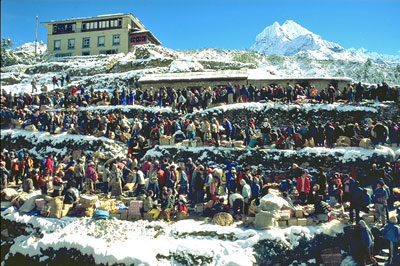
Market in Namche Bazar
This is my first trip to Nepal. I went together with Leny, Simon, Otto en Huub. The trip was organized by the Dutch agency HT Wandelreizen. We trekked in the Everest area. Simon published a detailed report on this trip on his web site.
Simon's report: show ...
My summary: show ...
Simon's report: show ...
My summary: show ...
1998 - Autumn (Kanchenjunga)

Kanchenjunga North face.
Kanchenjunga trek together with Otto.
HT Wandelreizen organized the trek for us. We fly from Kathmandu to Biratnagar and go, by car, via the tea town Ilam, to Gopetar where we start walking. First we go to the Kanchenjunga South Base Camp. From Tseram we cross via Milgin La, Sinion La en Tamo La to Ghunsa and go to the North Base Camp. Subsequently we retrace our track to Ghunsa and continue southward to Taplejung where we manage to catch a small plane to Kathmandu.
HT Wandelreizen organized the trek for us. We fly from Kathmandu to Biratnagar and go, by car, via the tea town Ilam, to Gopetar where we start walking. First we go to the Kanchenjunga South Base Camp. From Tseram we cross via Milgin La, Sinion La en Tamo La to Ghunsa and go to the North Base Camp. Subsequently we retrace our track to Ghunsa and continue southward to Taplejung where we manage to catch a small plane to Kathmandu.
2000 - Autumn (Everest trek, starting from Jiri)
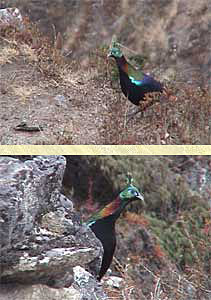
Danphe
Everest trek, together with Jan. Jan is married with the eldest daughter of my eldest brother.
HT Wandelreizen took care of the air tickets and the hotel reservations in Kathmandu. We have asked Kame Sherpa to organize and lead the trek. For Kame it is a good opportunity to practise guiding.
We fail to reach the Base Camp. In Lobuche Jan falls ill and we go down to Pheriche to the medical help post. The conclusion of the medical examination was "lack of water, not sufficient drinking". Jan recovers quickly. Of course we were disappointed, but making a tight planning, you have to accept that such things might happen and that there is no time for corrections. After all, the Everest trek is a very nice one and I had reached Lobuche, which is a kilometer further on the trek to the Base Camp, than the point which I reached in 1997. In that year I had to give up my aspirations during the climb just behind Dughla. Now, I was feeling satisfaction when I managed to pass the yaks during that climb. During the remaining part of our trek we enjoyed very much that we had some spare days available. Since this experience I make my planning less tight. Having more time is very rewarding.
We fail to reach the Base Camp. In Lobuche Jan falls ill and we go down to Pheriche to the medical help post. The conclusion of the medical examination was "lack of water, not sufficient drinking". Jan recovers quickly. Of course we were disappointed, but making a tight planning, you have to accept that such things might happen and that there is no time for corrections. After all, the Everest trek is a very nice one and I had reached Lobuche, which is a kilometer further on the trek to the Base Camp, than the point which I reached in 1997. In that year I had to give up my aspirations during the climb just behind Dughla. Now, I was feeling satisfaction when I managed to pass the yaks during that climb. During the remaining part of our trek we enjoyed very much that we had some spare days available. Since this experience I make my planning less tight. Having more time is very rewarding.
2001 - Autumn (Duble + Annapurna, the hard way)
Together with Kame Sherpa I go to his village, Duble. Without further staff, just the two of us, we trek from Jiri to Duble. Subsequently we continue to Rumjatar, for flying back to Kathmandu.
We were back in Kathmandu just in time to meet Leny, Simon and Otto for going on a trekking in the Annapurnas. This trek was organized by HT Wandelreizen. On their web site they advertise it as "Rond Annapurna | The hard way".
The trek starts in Kalika,near Pokhara, and crossses Namun Banjyang to Koto, a village along the standard Round Annapurna trek. Then a side trip to Nar and we join the standard trek again near Ngawal for continuing to Manang. From Manang we go to the Tilicho Lake and just north of the lake we cross to Jomsom.
We were back in Kathmandu just in time to meet Leny, Simon and Otto for going on a trekking in the Annapurnas. This trek was organized by HT Wandelreizen. On their web site they advertise it as "Rond Annapurna | The hard way".
The trek starts in Kalika,near Pokhara, and crossses Namun Banjyang to Koto, a village along the standard Round Annapurna trek. Then a side trip to Nar and we join the standard trek again near Ngawal for continuing to Manang. From Manang we go to the Tilicho Lake and just north of the lake we cross to Jomsom.
While Leny and Simon fly back to Kathmandu, Otto and I go to Marpha for climbing to the Damphus pass and a try of the Damphus peak.
After camping halfway the pass I crawl out of my tent and can barely walk anymore. My acquintance with hernia. I stumble back to Marpha and wait for the return of Otto. I do excercises and sit in the sun reading a book. I still remember the tasteful and juicy apples in Marpha. While reading I have eaten a lot of these apples.
Otto manages to reach the Damphus Peak and has a superb sight on Dhaulagiri. When he returns to Marpha I am able to walk again and we walk to Jomson for our flight to Kathmandu.
After camping halfway the pass I crawl out of my tent and can barely walk anymore. My acquintance with hernia. I stumble back to Marpha and wait for the return of Otto. I do excercises and sit in the sun reading a book. I still remember the tasteful and juicy apples in Marpha. While reading I have eaten a lot of these apples.
Otto manages to reach the Damphus Peak and has a superb sight on Dhaulagiri. When he returns to Marpha I am able to walk again and we walk to Jomson for our flight to Kathmandu.
2002 - Autumn (Tibet + Chitwan)
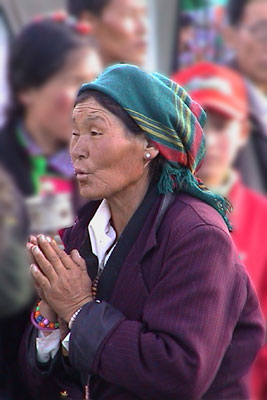
In Lhasa you always see many pilgrims
Together with Otto from Nepal, to Lhasa by plane, and from Lhasa back to Nepal, by car.
Last year, during the Annapurna trek, we had a good feeling about our guide. He gave us the impression that he could lead a trek to Tibet, on the condition that we booked the trip at his son's office in Kathmandu. We booked and experienced some surprises. His son merely had a ticket office and had forwarded the Tibet trip to a genuine trekking agency.
After we had some problems in Tibet, he did not accept his responsibilities and only after much talking he organized a meeting with the organizing agency.
Summary: show ...
After we had some problems in Tibet, he did not accept his responsibilities and only after much talking he organized a meeting with the organizing agency.
Summary: show ...
2003 - Spring (Duble + Chitwan)
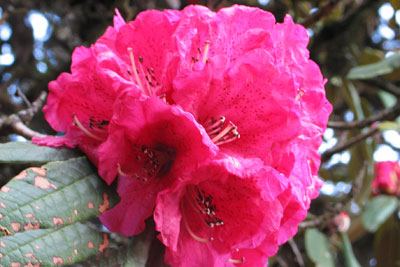
Rododendron
During previous treks I often walked in rhododendron forests. I liked to see flowering rhododendrons. Therefore, now a journey in springtime.
Summary: show ...
Summary: show ...
2003 - Autumn (Everest Base Camp in Nepal + Annapurna Base Camp)
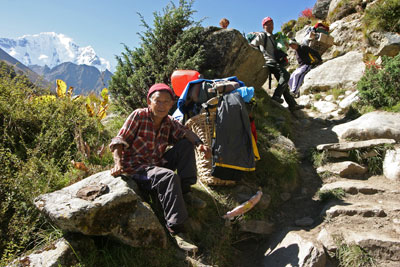
Rest, on the way to Dingboche. (foreground: Garma Sherpa).
With Jan, Anita's husband, I have planned to try the Everest Base Camp again.
For me it will be the third try.
Summary: show ...
For me it will be the third try.
Summary: show ...
2004 - Tibet (Langtang + Tibet + Chitwan)
2005 - Annapurna (Round Annapurna + Manaslu + Okhaldunga)
2006 - Langtang (Langtang + Helambu + Chitwan)
2007 - Chitwan, Lumbini
2008 - Autumn (Helambu + Lumbini + Bardia National Park)
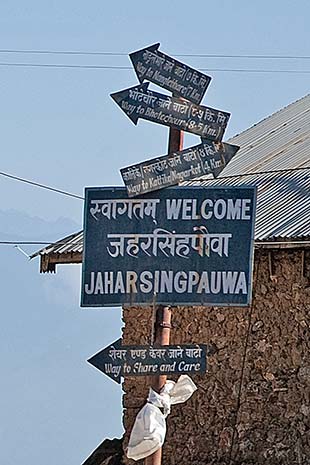
Jaharsingpauwa, the village where we begin our Helambutrekking.
Anita and I are together again.
You might remember that Anita is the eldest daughter of my eldest brother and is married with Jan.
In Helambu we follow a non-standard route.
We do not start in Sundarijal and we do not go to Tarkeghyang via Tharepati.
We start walking in Jaharsingpauwa and from Kutumsang we take an alternative route to Tarkeghyang, which stays at a lower altitude.
In Lumbini our visit coincides with the 17th Sakya Monlam. We only notice that when it shows up that we share the hotel restaurant with His Holiness Sakya Trizin and his accompaniment.
In Bardia we conclude that the Lonely Planet is outdated a little bit. The maoïst rebellion caused the temporarily closure of nearly all tourist facilities. At the moment people are restarting their business.
In Kathmandu however, the trekking agency thinks that everything is back at the old level again and competitive with Chitwan.
We have only been in Bardia Jungle Cottages, but our driver, of Trekking agency Multiadventure, had time to look around and I am sure that he reported to his boss. I assume that you can get updated information at the offices of Multiadventure.
Illustrated journal: show ...
You might remember that Anita is the eldest daughter of my eldest brother and is married with Jan.
In Helambu we follow a non-standard route.
We do not start in Sundarijal and we do not go to Tarkeghyang via Tharepati.
We start walking in Jaharsingpauwa and from Kutumsang we take an alternative route to Tarkeghyang, which stays at a lower altitude.
In Lumbini our visit coincides with the 17th Sakya Monlam. We only notice that when it shows up that we share the hotel restaurant with His Holiness Sakya Trizin and his accompaniment.
In Bardia we conclude that the Lonely Planet is outdated a little bit. The maoïst rebellion caused the temporarily closure of nearly all tourist facilities. At the moment people are restarting their business.
In Kathmandu however, the trekking agency thinks that everything is back at the old level again and competitive with Chitwan.
We have only been in Bardia Jungle Cottages, but our driver, of Trekking agency Multiadventure, had time to look around and I am sure that he reported to his boss. I assume that you can get updated information at the offices of Multiadventure.
Illustrated journal: show ...
2009 - Autumn (Trekking from Bahrabise to Sangutar + Chitwan Nationaal Park)
My stay in Nepal in 2009 had to be a bit special. After all, one doesn't turn 70 every year and this was going to be my year and it was going to happen to me during the trekking season. Thus, after having taken it rather easily for a few years, this year I wanted to include a somewhat bigger challenge. Such as the inclusion in the route of one of the higher passes, to let myself be overwhelmed by the views of the nearby high peaks. I chose Rolwaling for the purpose, a place I had not visited before. However, to go via the Trashi Labtsa, 5755 metres high, and towards Thame and Namche Bazar was rather too much of a challenge for me. Instead I opted for a route that would take me halfway through the Rolwaling valley before turning south and then over the the Yalung La, of 5310 metres, in the direction of Jiri and then on to Duble and Sanghutar. From Sanghutar one can take the bus or car back to Kathmandu.
Bahrabise was selected as the departure point.
The last section of the Yalung La is steep and often covered in ice. I therefore started my preparations with the purchase of a new pair of crampon-compatible climbing boots with an easy crampon-fitting mechanism. While I was walking-in these new boots, my planning was hit by the proverbial spanner in the works.
The last section of the Yalung La is steep and often covered in ice. I therefore started my preparations with the purchase of a new pair of crampon-compatible climbing boots with an easy crampon-fitting mechanism. While I was walking-in these new boots, my planning was hit by the proverbial spanner in the works.
Since 2001 I've known that I have metastasised prostate cancer. This was treated with hormones to slow down the spreading. However, it was becoming clear that the metastases were no longer showing the desired respect for the hormone treatment. Subsequent examinations showed that the original tumour was still quite localised and that I might benefit from undergoing a radiation treatment. I was given all possible cooperation for the speedy commencement of such a procedure and as a result I was able to start my trek within the season and still the recommended 5 weeks after the last radiation session.
However, since I had to take into account that my condition could deteriorate, the crossing of the Yalong La had to be taken out of the program making it a more leisurely trip. My motto was "I can still do everything but it will be at a slower pace".
To stress that one can do nice trekkings in Nepal, that are not too heavy, I write this report as a kind of diary of which two parts can be read as separate episodes.
Further reading:
- Complete journey (also the days in Kathmandu)
- Trek from Bahrabise to Sanghutar
- Stay in Chitwan
To stress that one can do nice trekkings in Nepal, that are not too heavy, I write this report as a kind of diary of which two parts can be read as separate episodes.
Further reading:
- Complete journey (also the days in Kathmandu)
- Trek from Bahrabise to Sanghutar
- Stay in Chitwan
